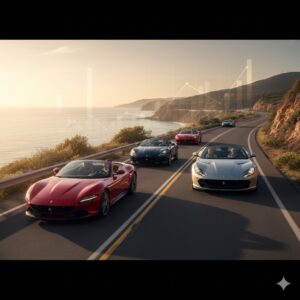Summary
The BCG Matrix of Ferrari provides a comprehensive strategic analysis of how the Italian luxury sports car manufacturer manages its product portfolio, market segments, and business lines. Ferrari is not just an automaker; it is a global symbol of performance, heritage, craftsmanship, exclusivity, and motorsport excellence. The Boston Consulting Group (BCG) Matrix, also called the Growth-Share Matrix, categorizes Ferrari’s product divisions into Stars, Cash Cows, Question Marks, and Dogs based on market growth and market share.
In this detailed and descriptive evaluation, the blog analyzes Ferrari’s core segments—Grand Tourers, sports supercars, hypercars, customization services, motorsports, and luxury merchandise. It explains how Ferrari’s limited production strategy, high demand, competitive positioning, and global brand equity shape the classification of each business.
The BCG Matrix of Ferrari (2025) highlights that Ferrari’s success is driven not only by extraordinary cars but also by its revenue-diversifying segments such as personalization, premium merchandise, and F1 racing involvement. This extensive, research-driven analysis helps readers understand Ferrari’s strategic resource allocation, long-term expansion priorities, and overall business sustainability.
Ferrari, founded in 1939 by Enzo Ferrari, is one of the most powerful luxury brands in the world. Headquartered in Maranello, Italy, Ferrari has evolved from a boutique racing team into a global manufacturer of ultra-premium sports cars, grand tourers, and hypercars. It caters to a rare segment of customers—high-net-worth individuals seeking exclusivity, luxury, and performance.
Unlike mass-market automakers, Ferrari operates with a unique business model: limited production, high personalization, premium pricing, and deep integration with motorsport. Ferrari delivers fewer than 15,000 cars a year but commands some of the world’s highest profit margins in the automotive industry.
Given its diversified portfolio—ranging from iconic cars like the 812 Superfast and SF90 Stradale to personalized Tailor-Made programs and its historic Formula 1 team—Ferrari benefits from applying the BCG Matrix to determine its strategic priorities.
The BCG Matrix of Ferrari provides a clear view of which segments drive revenue, which strengthen the brand, which require innovation, and which may need improvement or restructuring.
What is the BCG Matrix
The BCG Matrix categorizes business units or product segments using:
Market Growth Rate
Indicates how fast a product category is expanding globally.
Relative Market Share
Shows how dominant a company is compared to competitors within that segment.
Using these two axes, the BCG Matrix divides segments into:
Stars – High market growth and high market share
Cash Cows – High market share but low market growth
Question Marks – Low market share but high market growth
Dogs – Low market share and low market growth
Applying this framework to Ferrari reveals how the company strategically balances exclusivity with profitability in a highly competitive luxury performance market.
BCG Matrix of Ferrari – Detailed Analysis
Stars (High Market Share, High Market Growth)

Ferrari’s Hybrid and Electrified Supercars
Ferrari’s latest hybrid models—such as the SF90 Stradale, SF90 Spider, and 296 GTB—are positioned in the rapidly growing high-performance hybrid market. The global sports hybrid segment is expanding due to environmental regulations, consumer interest in advanced performance technology, and competition from brands like Porsche, McLaren, and Lamborghini.
Ferrari’s electrification strategy is strong:
It offers extreme performance with hybrid systems
It integrates F1-inspired engineering
It is on track to launch Ferrari’s first full-electric car in 2025
Because hybrid supercars have both high growth and high consumer demand, Ferrari holds a leading position in this segment. This makes electrified Ferrari models key Star products in the BCG Matrix.
Ferrari’s Limited-Edition Hypercars
Ferrari’s hypercars—LaFerrari, FXX-K Evo, Daytona SP3, and the Icona series—are prime examples of high-growth luxury categories with extraordinary demand. Hypercars are sold only to select customers, often before public announcements, and they command extremely high resale value.
The hypercar market has high growth because:
Ultra-wealthy customers are increasing worldwide
Collectible investments are rising
Limited-edition engineering attracts global attention
Ferrari’s dominance in this elite category—supported by heritage and technology—makes hypercars a Star segment.
Ferrari’s Personalization and Tailor-Made Programs
The Tailor-Made program allows customers to personalize interiors, exteriors, materials, and performance features. Luxury personalization is one of the fastest-growing segments globally.
Customers increasingly want one-of-a-kind cars
Ferrari profits heavily from personalization packages
It enhances customer loyalty and brand exclusivity
This segment has high profit margins and high growth, making it a strategic Star for Ferrari.
Cash Cows (High Market Share, Low Market Growth)

Traditional V8 and V12 Grand Tourers
Ferrari’s traditional V8 and V12 models—Roma, Portofino, 812 Superfast, and F8 Tributo—represent the brand’s identity. These sports GTs are profitable and enjoy strong global recognition. However, this category is maturing, and growth is stabilizing due to stricter emission regulations and the emergence of hybrid performance cars.
Yet Ferrari maintains dominance with:
Strong brand equity
High demand among enthusiasts
Premium pricing
These cars remain highly profitable, making them Ferrari’s essential Cash Cows.
Ferrari Merchandise and Licensing
Ferrari’s brand is one of the strongest in luxury retail. Merchandise categories include:
Fashion apparel
Luxury accessories
Watches
Collectibles
Children’s merchandise
Although merchandise growth is slower than automotive growth, Ferrari’s brand power gives the segment high profitability and consistent revenue.
High market share but moderate market growth positions Ferrari merchandise as a Cash Cow.
Ferrari’s Pre-Owned Car Market
Ferrari’s certified pre-owned cars often sell for more than their original price, thanks to controlled supply and high demand. The pre-owned market:
Has stable growth
Generates reliable revenue
Strengthens brand value
Ferrari’s control over resale and authenticity ensures a high market share, making it a Cash Cow for the company.
Question Marks (Low Market Share, High Market Growth)

Ferrari’s SUV Segment – Purosangue
Purosangue, Ferrari’s first-ever four-door crossover, targets the booming global luxury SUV market. Competitors include:
Lamborghini Urus
Aston Martin DBX
Bentley Bentayga
Rolls-Royce Cullinan
The luxury performance SUV market is one of the fastest-growing automotive segments. However, Ferrari is a new entrant, and its market share is still developing.
High growth but low share positions Purosangue as a Question Mark.
With strong brand loyalty and innovation, it can evolve into a Star over time.
Ferrari’s Electric Car Division (Upcoming)
Ferrari plans to launch its first fully electric car in 2025. The electric luxury supercar market is extremely high growth, but Ferrari currently has no market share since the product hasn’t launched yet.
This makes Ferrari’s EV division a Question Mark, but with extreme potential to become a Star or even the company’s flagship category in the coming decade.
Dogs (Low Market Share, Low Market Growth)

Ferrari’s Non-Core Retail Stores (Low-Performing Locations)
Some Ferrari stores in certain regions do not perform strongly due to:
Low demand
Lack of premium customer base
High operational costs
These locations contribute limited value and fall under the Dogs category.
Ferrari Theme Parks (Limited Growth)
Ferrari World Abu Dhabi and Ferrari Land Spain attract tourists but have:
High operating costs
Moderate global growth
Low expansion interest
These non-core businesses have lower profitability and limited market share, classifying them as Dogs.
Strategic Insights from the BCG Matrix of Ferrari
The BCG Matrix of Ferrari (2025) reveals Ferrari’s ability to maintain profitability, exclusivity, and global prestige. Several strategic insights emerge:
Ferrari’s Stars represent the future of the company
Hybrid performance cars and hypercars drive innovation and brand prestige
Cash Cows maintain Ferrari’s financial stability
Grand tourers, merchandise, and pre-owned markets ensure predictable revenue
Question Marks highlight Ferrari’s exploration of new markets
SUVs and EVs represent expansion areas requiring careful investment
Dogs show the need for strategic pruning
Underperforming retail and theme parks may require rethinking or restructuring
This balance allows Ferrari to remain financially strong while investing heavily in technological evolution and future-focused automotive categories.
Also Read: BCG Matrix of Reliance Industries
Challenges in Applying the BCG Matrix to Ferrari
Ferrari’s unique business model introduces challenges:
Its limited production strategy skews market share analysis
Luxury car buying patterns are unpredictable
Ferrari’s emotional and symbolic value influences sales
Hypercars cannot be measured like mass-market segments
Ferrari’s small volume makes certain segments inherently niche
However, the BCG Matrix still provides essential insights into Ferrari’s long-term strategy and investment priorities.
Conclusion
The BCG Matrix of Ferrari (2025) clearly illustrates how Ferrari sustains its position as a global luxury performance leader. Ferrari’s diversified portfolio shows strong health, long-term viability, and strategic depth.
Star segments reflect Ferrari’s innovation in electrified and high-performance categories
Cash Cows uphold brand strength and financial stability
Question Marks represent bold expansion moves into SUVs and electric vehicles
Dogs identify areas requiring strategic reconsideration
Ferrari’s future remains strong, driven by innovation, exclusivity, and evolving luxury trends. Its strategic portfolio management positions the brand for leadership in the next generation of electric, hybrid, and high-performance automotive markets.
FAQs
What is the BCG Matrix of Ferrari?
It is a strategic framework analyzing Ferrari’s business segments based on market growth and market share.
Which Ferrari segments are Stars?
Hybrid supercars, hypercars, and Tailor-Made personalization are key Stars.
What are Ferrari’s Cash Cows?
Grand tourers, traditional sports cars, Ferrari merchandise, and the certified pre-owned program.
Which Ferrari divisions are Question Marks?
Purosangue SUV and Ferrari’s upcoming electric vehicle program.
Which segments fall into the Dogs category?
Underperforming Ferrari retail stores and Ferrari theme parks.

